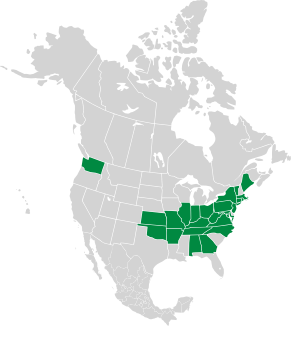Cypripedium calceolus L. var. parviflorum (Salisb.) Fernald
Cypripedium calceolus L. ssp. parviflorum (Salisb.) Hultén
Cypripedium hirsutum Mill. var. parviflorum (Salisb.) Rolfe

|
Cypripedium parviflorum Salisb. var. parviflorum Small yellow lady’s slipper, yellow lady’s slipper
Yellow lady's slippers, members of the orchid family, are native to North America, and may be native to Eurasia as well. It is not clear whether the Eurasian varieties are separate species. Because these species are highly variable, botanists also have a difficult time distinguishing among several varieties of North American yellow lady's slippers. Identification: Plants are 6-16″ (15-40 cm) high, smaller in exposed or cold conditions, or in calcium-bearing soil. Leaves are egg-shaped, folded lengthwise, 2-6″ (6-15 cm) long and 1-3″ (3-8 cm) wide. The yellow, slipper-like flower is called the lip, and is 1-2½″ (3-7 cm) long and ⅛-1″ (6-30 mm). Petals are dark reddish brown. Although they are densely spotted, the spots are so small that the effect is uniformly dark, vs. blotchy as with other varieties. The flowers may have a rose-like fragrance. Produces one or two flowers per stem. Here are some varieties of yellow lady's slippers. Some botanists believe Cypripedium parviflorum var. parviflorum and C. parviflorum var. pubescens are the same species. |
5/15/2010 · Garden in the Woods, Framingham, Massachusetts · ≈ 9 × 14″ (23 × 35 cm) 5/22/2010 · Garden in the Woods, Framingham, Massachusetts · ≈ 7 × 4½″ (17 × 11 cm) |
|||||||||||||||||||||||||||||||
|
| ||||||||||||||||||||||||||||||||
| You are here Cypripedium parviflorum var. parviflorum |
||||||||||||||||||||||||||||||||
|---|---|---|---|---|---|---|---|---|---|---|---|---|---|---|---|---|---|---|---|---|---|---|---|---|---|---|---|---|---|---|---|---|
| Common Name |  |
|||||||||||||||||||||||||||||||
| Plant | 6-16″ (15-40 cm) high, smaller in exposed or cold conditions, or in calcium-bearing soil. | |||||||||||||||||||||||||||||||
| Flowers | Yellow, 1-2½″ (3-7 cm) × ⅛-1″ (6-30 mm). Petals are dark reddish brown. Although densely spotted, the spots are so small that the effect is uniformly dark, vs. blotchy as with other varieties. 1-2 flowers per stem. | |||||||||||||||||||||||||||||||
| Leaves | Elliptical, folded lengthwise, 2-6″ (6-15 cm) long and 1-3″ (3-8 cm) wide. | |||||||||||||||||||||||||||||||
| Range/ Zones |
|
|||||||||||||||||||||||||||||||
| Type | Wild | |||||||||||||||||||||||||||||||
Online References:
5/15/2010 · Garden in the Woods, Framingham, Massachusetts · ≈ 9 × 6″ (23 × 15 cm) 
Cypripedium calceolus L. var. parviflorum (Salisb.) Fernald
Cypripedium calceolus L. ssp. parviflorum (Salisb.) Hultén
Cypripedium hirsutum Mill. var. parviflorum (Salisb.) Rolfe
Cypripedium parviflorum var. parviflorum description by Thomas H. Kent, last updated 16 Sep 2020.
© FloraFinder.org. All rights reserved.
5/15/2010 · Garden in the Woods, Framingham, Massachusetts · ≈ 8 × 12″ (20 × 31 cm) ![]() ID is uncertain
ID is uncertain 
5/15/2010 · Garden in the Woods, Framingham, Massachusetts ![]() ID is uncertain
ID is uncertain 
Range:
